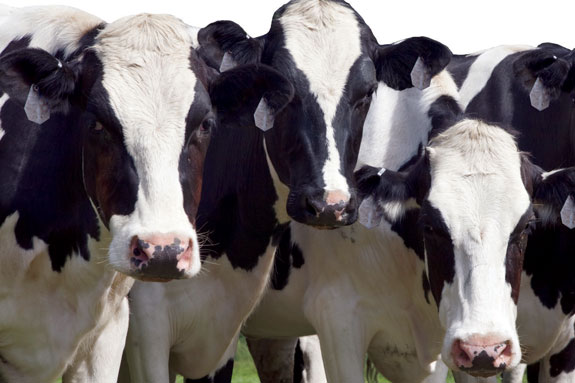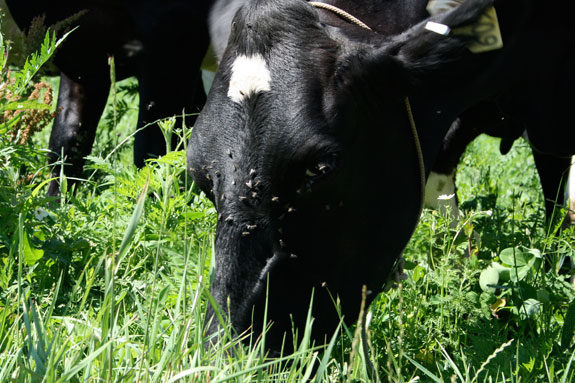There are many cattle diseases to be concerned about as a dairy producer, but pinkeye is one of the more highly contagious diseases. It is an infectious bacterial disease of the eye of cattle caused by Moraxella bovis. It has been documented around the world. Even though pinkeye is a non-fatal disease, it does have a staggering economic impact on the cattle industry. Pinkeye continues to be prevalent throughout the United States and is considered a major economic health problem for the dairy industry.
Pinkeye commonly occurs in the summer and fall, and younger cattle are more susceptible to the disease because older animals have most likely developed acquired immunity as a result of previous exposure.
The prevalence and severity of pinkeye on a particular dairy may vary from year to year and is dependent on multiple factors. Infection rates may range from a few cases up to 80 percent of the herd at the peak of infection.
Pinkeye doesn’t just look nasty. It can affect your cows’ performance and rob you of significant profits.For example, pinkeye-infecteddairy cows may drop as much as 25 percent in milk production, plus they can lose significant weight and body condition.
Pinkeye causes
The bacteria Moraxella bovis is the primary infectious agent initiating pinkeye.
Other organisms that can initiate pinkeye include Chlamydia, Mycoplasma and Acholeplasma, or viruses such as the Infectious Bovine Rhinotracheitis (IBR) virus, which can either add to the severity of the disease process or may serve as predisposing factors permitting a secondary infection with Moraxella bovis.
Other factors that are instrumental in causing eye irritation are excessive sunlight, flies, plant material and dust, and they can lead to allowing invasion of the bacteria and subsequent disease.
Excessive sunlight is a problem for cattle lacking pigmentation around the eye. Lack of pigmentation allows increased ultraviolet radiation to sensitize the eye, resulting in inflammation and infection.
Pinkeye transmission and symptoms
Transmission of pinkeye occurs through direct contact, flies and inanimate objects. The organism is located in the eyes and nasal cavities of infected cattle. Infected secretions from these areas are a source of infection for other cows.
Some cattle may show no symptoms of the disease but may be carriers and will harbor the disease for over a year. These carrier cattle are real problems because they allow for the persistence of pinkeye at a farm from year to year.
The most obvious symptoms of pinkeye are swelling and redness of the conjunctiva, excessive tearing, and squinting. Dairy cows will usually have a depressed appetite due to the excessive pain and some high body temperature.
A small opaque area appears in the center of the cornea in about two days and usually within a week the entire cornea will have a gray-white to yellow color with deep central ulceration of the cornea.
Severe ulceration, bulging of the eye and blindness usually do not occur. More times than not, complete recovery occurs in three to five weeks with only a few affected cattle having a persistent white scar on the cornea.
Prevention starts with fly control
But we all know that the major cause of pinkeye is flies. Flies serve as irritants and they feed on secretions from the eye. They also serve as a means of transmitting the disease from infected to non-infected cattle.
While many of us in the cattle industry only look at flies as an irritant to our cows, the economic numbers are real.
University of Tennessee beef researchers show us that not treating flies can cost a producer more than $120 per animal/year in gains. Now add in the devastating effects of a pinkeye infection – which can cause you to cull the animal before it can provide an income to the operation and affect its processing status – and you can’t afford not to control flies.
Pinkeye can be avoided with the placement of an insecticide ear tag for less than $2.00 per ear.
This course of action also eliminates the need for expensive and controversial antibiotics such as oxytetracycline, ceftiofur, penicillin and sulfonamides – the preferred route of control with pinkeye infection.

However, while insecticide ear tags are a smart investment for overall fly control (especially against horn flies), face flies require organophosphate-based ear tags.
A good organophosphate (diazinon) can provide significant face fly reduction for several weeks. But this needs to be teamed with an all-out blitz of pour-ons, backrubs, spray and larvicides to keep face flies in check.
Devices that allow animals to treat themselves frequently and which target the head and face area are most effective against face flies.
Even if a good pasture fly control program is in place, these insects are strong fliers so they may move in from other herds and allowing fly numbers on animals to remain high.
Backrubbers with wicks or fly flips will allow cattle to treat themselves while loafing and scratching.
Broad-spectrum insecticides should be diluted with a good grade of mineral oil (diesel oil evaporates more quickly and is harder on the animal's skin) according to label instructions. Do not use motor oil.
Dust bags containing broad-spectrum insecticides are most effective when used where cattle have to pass under them daily to get to water or mineral feeders. Best coverage occurs when the animal must lift the bag with its head to pass through.
Inspect the bag regularly and recharge it as needed. Keep it dry to reduce clumping of the insecticide and premature loss of effectiveness. Also, rotate between insecticide classes to help extend the effectiveness and duration of control.
Feed additives target face fly maggots breeding in fresh animal manure. All animals must eat a minimal dose of a feed additive regularly. Supplementary control measures must be taken to deal with flies moving in from nearby herds.
Pinkeye treatment
Long acting oxytetracycline has been shown to be an effective treatment in calves when used early in the disease process. It sometimes will clear pinkeye from the infected eye in 24 hours of the first injection.
When severe corneal ulceration exists, you should protect the eye from sunlight, flies and other irritants through the use of eye patches or suturing the eyelids.
Commercial pinkeye vaccines are also available. The results reported from producers that use the vaccines are mixed. You should check with your veterinarian to determine the best method(s) for preventing pinkeye and other diseases.
Management is usually the most effective and economical method of disease control. Properly managed environmental conditions, nutrition and herd immunity increases animal health and decreases disease frequency.
A decline in disease frequency results in a decrease in concentration of infective organisms on the farm. PD

Skip French
Eastern Region Sales Manager
KMG Animal Health
sfrench@kmgchemicals.com







